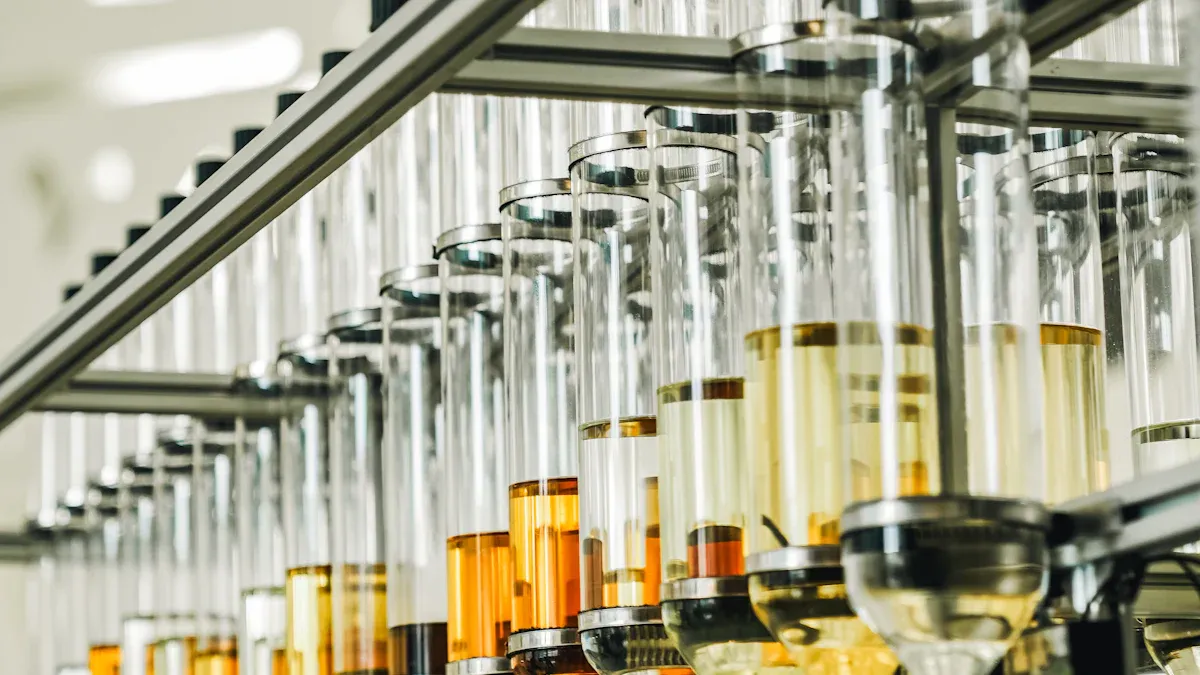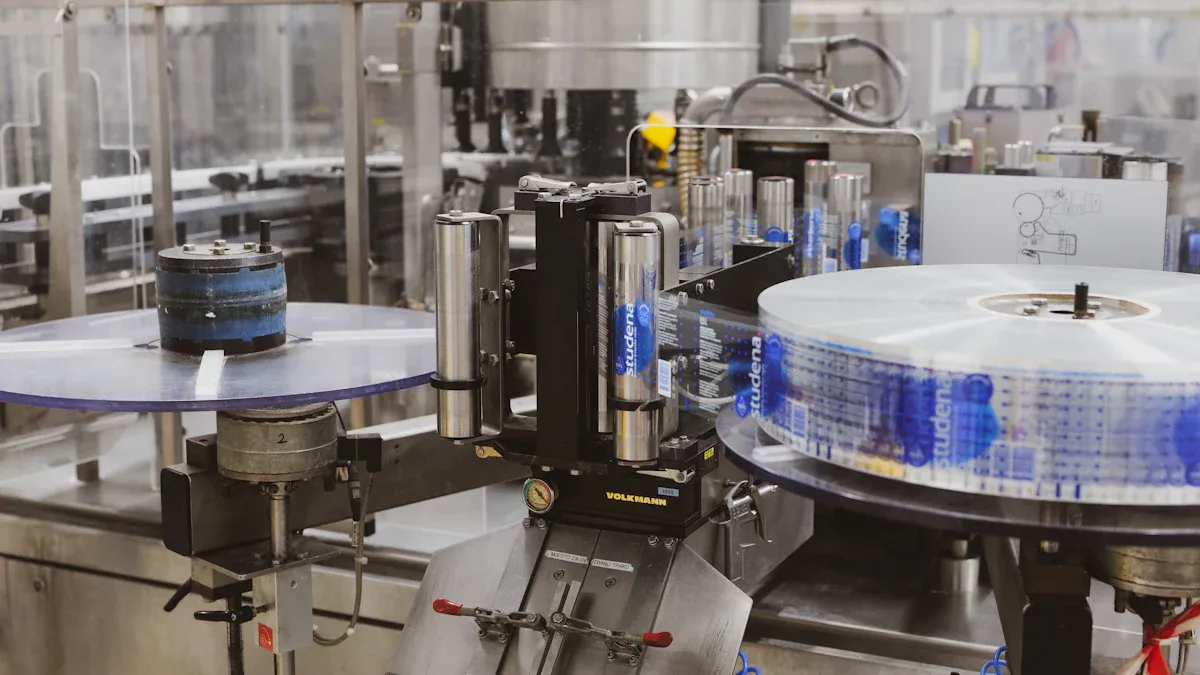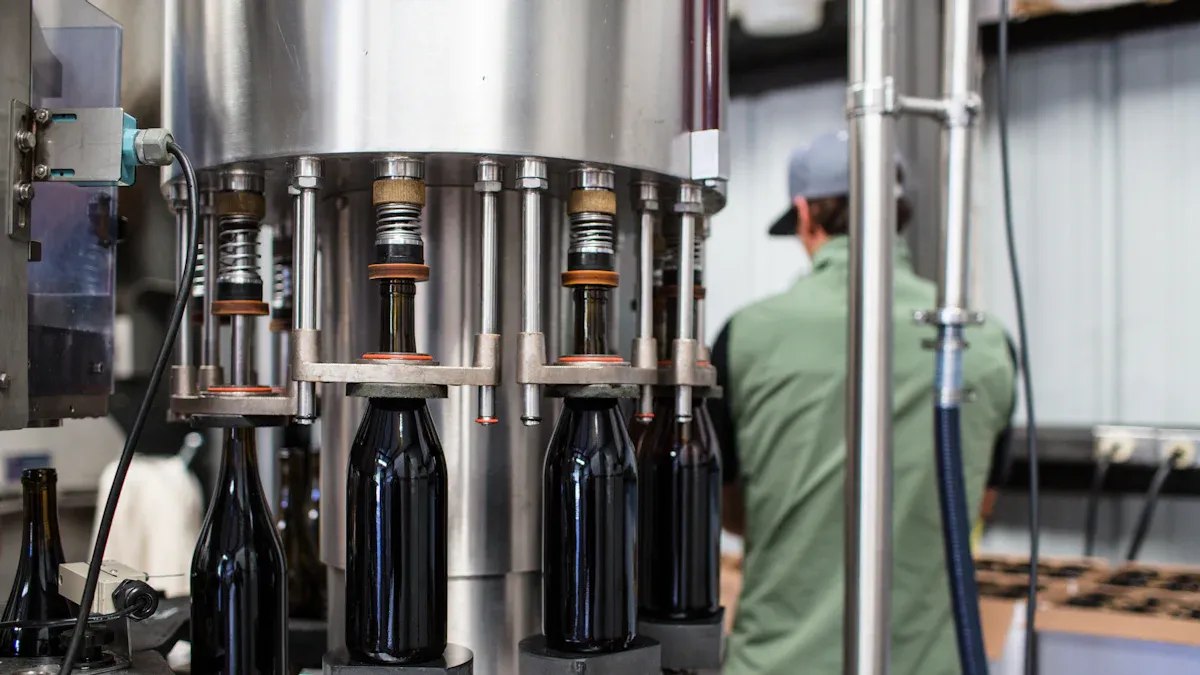
Automatic bottle water filling machines make your work easier. They do rinsing, filling, and capping all at once. This saves time and effort. You can use these machines for many bottle sizes and types. They work with small 500ml PET bottles and big 5-gallon water jugs. The table below lists some common choices these machines can handle:
Aspect | Details |
Common Bottle Sizes | 500ml, 1L PET bottles; 5 gallon water bottles |
Bottle Types | PET bottles (small sizes), gallon water bottles (large sizes) |
Cap Types | Screw caps for PET bottles; snap-on caps for gallon jugs |
Learning about the main technologies, parts, and benefits is helpful. It lets you run bottling jobs that are steady and work well.
Automatic bottle water filling machines rinse, fill, and cap bottles. They do this quickly and smoothly. They can work with many bottle sizes and shapes.
Smart technologies like gravity, vacuum, back-pressure, and volumetric filling help fill bottles accurately. They keep the water fresh and help stop waste.
Strong materials like SUS316L stainless steel and special filling valves keep the machines clean. They also make the machines safe and simple to take care of.
PLC control and air conveyors help the machines work faster. They make the machines flexible and cleaner. They also help stop mistakes and machine stops.
These machines help every bottle look the same. They can fill bottles up to 25 times faster. They help save water and can change for new bottle sizes or business needs.
Automatic bottle water filling machines use a monoblock system. This system puts many steps together in one process. You can use it for different bottle sizes and types. It works with PET, PVC, and barrels. You do not need to do much by hand. The machine brings bottles in, rinses, fills, and caps them. This makes your work fast and steady.

First, you put empty bottles on a conveyor. Sensors see each bottle and line it up under the filling heads. Star wheels help move bottles between stations. Good alignment stops jams and keeps bottles moving right. If bottles are not lined up, the machine can stop. Guide rails and servo motors help fix this for different bottles. Checking the machine often and training workers helps avoid mistakes.
Tip: Check guide rails and conveyors often. This helps keep bottles lined up and stops delays.
When bottles go in, they reach the rinsing station. The machine turns each bottle upside down to clean inside. Water jets spray hard to wash out dust and dirt. Some machines use both water and air to clean better. Filters and recirculation save water and money. Each rinse takes only a few seconds and uses little water. You must follow hygiene rules like FDA, ISO 22000, and HACCP. The machine uses clean water or safe cleaning solutions. You also need to keep cleaning records.
Bottles turn over for inside cleaning.
Strong water jets remove dirt.
Water and air rinsing make bottles cleaner.
Filters help use less water.
You must follow FDA and NSF rules.
After rinsing, bottles go to the filling station. Sensors check fill levels to make sure they are right. RF Admittance and Magnetostrictive sensors help keep fills even. These sensors work even if water changes temperature or thickness. Rotary volumetric fillers use piston-cylinder parts to control water amounts. The machine can fill up to 600 bottles each minute. Inspection systems check for bottles that are too full or not full enough. Temperature control helps keep filling even. Training and regular checks keep the machine working well.
Step | Description |
Bottle Positioning | Sensors line up bottles under filling heads |
Fill Level Control | Sensors keep fills correct |
Volumetric Filling | Piston-cylinder parts keep water amounts even |
Inspection | Inline systems find fill mistakes |
Speed | Up to 600 bottles each minute |

The last step is capping. Rotary capping heads move with the bottles and put on caps. Anti-rotation blades hold bottles still while capping. Automatic cap loaders keep caps coming, so you do not need to touch them. The machine works with many screw cap sizes and types. The capping process picks, places, twists, and lets go of the cap. Cams control these steps for accuracy.
Rotary capping heads move with bottles.
Anti-rotation blades keep bottles from turning.
Automatic cap loaders mean less work for people.
Works for screw caps from 200ml to 2000ml bottles.
Note: Keeping caps moving and feeding them automatically stops delays and helps the line run better.
Automatic bottle water filling machines put all these steps in one machine. This saves space and makes production faster. You can use many bottle types and keep things clean and accurate. This helps your bottling work go smoothly.
Automatic bottle water filling machines use many smart technologies. These help the machines work fast, clean, and accurate. Each technology has special uses and benefits. Knowing about these helps you pick the best machine for your needs.
Filling Technology | Operating Principle | Suitable Product Types | Key Advantages |
Gravity Filling | Uses natural head pressure (gravity) | Water-thin products | Simple, cost-effective, reliable fill levels |
Vacuum Filling | Applies negative pressure to remove air and reduce oxidation | Sensitive products, glass containers | Improves hygiene, extends shelf life |
Back-Pressure Filling (Balanced Pressure) | Balances pressure between tank and container | Viscous liquids | Enhances fill accuracy and production efficiency |
Volumetric Filling | Measures and dispenses precise volumes (e.g., piston or cup) | Wide range of viscosities | Accurate volume control, versatile for many products |
Gravity filling is a popular way to fill bottles with water. Many automatic machines use this method. The system has a tank above the filling nozzles. Water sits in the tank until bottles are ready. When a bottle is in place, a valve opens for a short time. Water drops down into the bottle using gravity. Each fill head has its own timer. This makes sure every bottle gets the same amount of water. Gravity filling works best for thin liquids like water. It is easy to use and does not break often. You save money and time with this method.
Tip: Gravity filling machines use sub-surface nozzles. These help stop foam and keep your line clean.
Vacuum filling uses air pressure to pull liquid into bottles. The machine seals the bottle rim to the nozzle. This seal removes air from the bottle. Less air means less oxidation and better hygiene. Vacuum filling is good for products that need to stay fresh. You see it used for wine and spirits. It also works well for clear glass bottles. Every bottle looks neat and filled right. But vacuum filling needs the air outside the bottle to be higher. If the pressure is not right, it may not work well.
Vacuum filling keeps fill levels the same.
It helps keep bottles clean and fresh longer.
It works best for sensitive or clear products.
It may not work if pressure is wrong.
Back-pressure filling is important for fizzy drinks like carbonated water. This method keeps bubbles inside the bottle. The machine puts CO2 gas into the bottle. This matches the pressure of the liquid coming in. Bubbles do not escape, so drinks stay fresh. A rod connects the bottle to the liquid channel. Water flows around the rod gently. This stops bubbles from popping. Clean air keeps the pressure steady. When the bottle is full, the rod drops and seals the bottle. Special meters and controls help fill bottles exactly right.
Back-pressure filling keeps bubbles in carbonated water.
CO2 gas matches pressure and stops foam.
Controls make fills accurate and steady.
This method is fast and makes high-quality drinks.
Volumetric filling gives you exact control over how much liquid goes in each bottle. The machine measures and puts in a set amount every time. Piston fillers use a cylinder and piston to push out the right dose. Timed flow fillers use time to control how much water goes in. Both ways help you waste less and keep quality high. Volumetric filling works for thin and thick products. In bottle water filling, it makes sure every bottle has the right amount.
Volumetric Filling Method | Mechanism | Suitable Product Type | Role in Maintaining Consistency |
Piston Fillers | Use a cylinder and piston to draw and dispense a fixed volume | Viscous products (e.g., sauces, creams, gels) | Ensures constant volume dispensed, precise dosing, uniform fill levels |
Timed Flow Fillers | Control volume dispensed based on timing | Free-flowing liquids | Accurate volume control via timing, reduces product waste, maintains uniform fills |
Note: Volumetric fillers help keep quality high and waste low. They are a smart choice for steady production.
You want your bottle water filling machine to last a long time. It should also stay clean. Manufacturers use SUS316L stainless steel for all water contact parts. This metal has molybdenum, which helps stop rust and corrosion. It works well even with salty or acidic water. SUS316L can handle strong cleaning chemicals. It meets strict food safety rules. You can take the parts apart quickly for cleaning. This makes it easy to keep the machine safe and running well.
Tip: SUS316L stainless steel costs more at first, but it saves you money over time by reducing repairs and downtime.
Filling valves help keep your water safe and your line fast. Advanced valves use smooth tubes and special seals to stop leaks. They are easy to clean. Some do not use O-rings, so you spend less time fixing them. These valves fill bottles quickly and very close to the right amount. They work in a clean area, so germs stay out. You can switch bottle sizes fast. The valves work with many water types.
Fast and accurate filling
Easy to clean with fewer parts to fix
Every bottle gets the same fill
A PLC is like the brain of your bottle water filling machine. It controls every step, from finding bottles to putting on caps. You get a touchscreen or panel to set up the machine. You can change settings for different bottles or fill amounts. The PLC system helps stop mistakes and saves work. It keeps your line running fast. It also checks for problems and stops the machine if needed. This keeps your work safe.
Note: PLC control lets you change settings quickly and keeps your production flexible.
Air conveyor systems move bottles with air, not belts or rollers. This keeps bottles clean and stops them from wearing out. You can move many bottles each minute without jams or damage. Air conveyors need little care and fit into your line easily. They help you keep up with fast production and lower the chance of germs.
Automatic bottle water filling machines fill hundreds or thousands of bottles every hour. You can finish big orders fast because the system uses conveyors, many fillers, and capping at the same time. Manual filling is much slower. High speed means you can grow your business and help more customers without waiting.
Feature | Benefit |
Up to 6,000 bottles per hour | |
Flexible bottle sizes | Quick changeovers for different containers |
Easy maintenance | Less downtime and lower labor costs |
Food safety compliance | Meets hygiene standards for safe production |
It is important that every bottle has the same water amount. Automatic machines use smart parts to make this happen. Volumetric piston fillers put the right amount in each bottle. Mechanical stops set clear fill limits. Adjustable trays keep bottles in the right place. Float valves stop water at the right time. Valve-controlled drains and nozzles with stops stop spills and overfills. All these parts work together to keep fills steady for all bottle sizes. You save money because you waste less water.
Automatic machines make your work much faster. The table below shows how many bottles you can fill each hour:
Machine Type | Production Speed (bottles/hour) | Increase Compared to Manual |
Manual | ~200 | Baseline |
Semi-Automatic | 500–800 | ~2.5 to 4 times faster |
Fully Automatic | 2,000–5,000 | ~10 to 25 times faster |
You can fill thousands of bottles every hour. This helps you finish big orders and grow your business.
Automatic machines help you use less water and fewer supplies. Here’s how they do it. High-accuracy filling stops overfilling and spills. Automation removes mistakes people make. Eco-friendly systems recycle wash water and use less for cleaning. Machines work with recyclable and compostable packaging. Faster lines and less downtime mean less waste from stops and errors. You save money and help the planet.
You can change your line for many bottle types and future needs. PLC control lets you set up the machine for different bottles. Fast lines work with many shapes and sizes. Adjustable nozzles and volume knobs make changes easy. Upgradable filler heads let you add more later. Capping and labeling modules help you upgrade in the future. You stay ready for new products and market changes.
Automatic bottle water filling machines make bottling easier and faster. They help you get more bottles done in less time. You also get the same results every time and waste less. When picking a machine, think about what you will fill, the bottle size, and how much you want to grow. The table below shows important things to look at:
Factor | What to Check |
Product Type | Liquid, gel, or powder |
Bottle Compatibility | Size, shape, and material |
Production Capacity | Daily output and speed needs |
Automation Level | Manual, semi-automatic, or fully automatic |
Sanitation & Compliance | Hygiene standards and cleaning features |
Support & Maintenance | Technical help and spare parts availability |
Look at how you do things now. You might see that using machines can really help your business.
You need to follow the cleaning steps from the manufacturer. Use cleaning solutions that are safe for food. Take apart the parts that touch water. Clean and sanitize these parts every day.
Tip: Plan deep cleaning often so bacteria does not grow.
Yes, you can set up most machines for different bottle sizes. You need to move the guide rails and change the filling heads.
Bottle Size | Adjustment Needed |
500ml | Minor |
5 Gallon | Major |
A machine that is cared for can last 8 to 15 years. Doing regular maintenance and using good parts helps it last longer.
Clean every day
Change old parts
Have a yearly checkup
You do not need hard skills. Most machines have touchscreens and easy controls. Basic training teaches setup, cleaning, and fixing problems.
Note: Ask your supplier for videos or manuals for training.